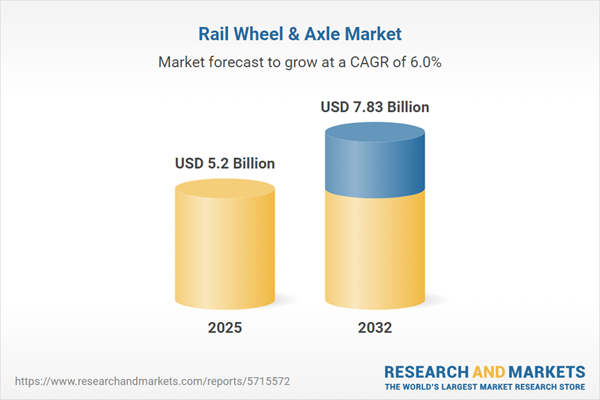Speak directly to the analyst to clarify any post sales queries you may have.
Senior executives in the rail wheel and axle market are navigating an environment defined by continual regulatory evolution, increased sustainability demands, and fast-paced technological change. Success in this sector depends on timely, actionable market intelligence that informs resilient and strategic business decisions.
Market Snapshot: Rail Wheel & Axle Market Analysis
The global rail wheel and axle market is valued at USD 4.91 billion in 2024, with projections indicating growth to USD 5.20 billion by 2025 and USD 7.83 billion in 2032. This robust expansion is fueled by sustained investments in the modernization of rail infrastructure, vital for both freight and passenger segments. Regulatory bodies worldwide are intensifying standards, leading organizations to prioritize technology upgrades, compliance, and sustainability within their operations. Forward-thinking companies that proactively align their strategies to evolving conditions are better positioned to address rising demand for dependable and efficient rail equipment.
Scope & Segmentation of the Rail Wheel & Axle Market
A comprehensive understanding of the rail wheel and axle market’s scope and segmentation is crucial for developing efficient resource allocation strategies and aligning organizational goals with current market dynamics.
- Application: Products and solutions serve freight, high-speed, metro, intercity, light rail, and commuter rail systems. Each application brings distinct engineering requirements, operational priorities, and service lifecycles, making targeted product design and operational strategy essential.
- Material Types: The market features steel, cast iron, and advanced composite materials, each contributing advantages in durability, weight management, and adherence to increasing environmental standards.
- Product Types: Offerings include discrete wheels, individual axles, and fully integrated wheel sets. These support both wholesale fleet renewals and modernization projects focused on enhancing system performance and longevity.
- End Users: Key segments involve original equipment manufacturers driving technology integration and aftermarket service providers supporting maintenance and asset reliability over the operational lifecycle.
- Distribution Channels: Delivery occurs through direct OEM supply, independent distribution partners, and established aftermarket networks, ensuring coverage for diverse project and regional demands.
- Regional Coverage: The rail wheel and axle industry has a solid footprint across the Americas, Europe, Asia-Pacific, and the Middle East & Africa. Each region displays unique regulatory approaches, investment priorities, and pathways to engaging with suppliers.
- Company Profiles: Leading firms such as CRRC Corporation Limited, Amsted Rail Company, Lucchini RS S.p.A., voestalpine AG, Alstom SA, Siemens Mobility GmbH, Bharat Forge Limited, Titagarh Wagons Limited, Japan Steel Works, and Progress Rail contribute to global infrastructure growth and project execution.
Key Takeaways for Senior Decision-Makers
- Adoption of digital asset management and monitoring platforms is increasing, giving operating teams better oversight of fleet status and optimizing maintenance schedules for improved reliability.
- Customized engineering approaches aligned with local and regulatory needs support compliance management while streamlining delivery and implementation processes.
- Deployment of advanced materials empowers operators to meet evolving safety, durability, and sustainability benchmarks, reducing lifecycle costs and downtime.
- Collaborative partnerships between OEMs, technology developers, and research organizations are strengthening innovation cycles, while also driving supply chain robustness across global networks.
- Enhanced aftermarket services, combined with flexible distribution models, help clients adapt to dynamic market conditions and maintain higher fleet availability.
- Utilization of diversified sourcing and procurement strategies allows firms to mitigate risks associated with shifting regulations and supply disruptions across regions.
Tariff Impact and Strategic Implications
Anticipated U.S. tariffs in 2025 introduce new considerations for procurement strategies. Organizations are increasing reliance on local suppliers and building resilient relationships to support adaptive sourcing models. Emphasizing process flexibility and unwavering quality standards will help leadership teams remain agile while fulfilling compliance demands and managing cost fluctuations in an evolving regulatory climate.
Methodology & Data Sources
This market analysis combines insights from interviews with senior executives, thorough technical assessments in rail and metallurgy, and scenario-based planning. Data is validated using rigorous cost analysis methods to ensure findings support informed strategic choices.
Why This Rail Wheel & Axle Market Report Matters
- This report delivers actionable insights to support senior leadership in making informed procurement and technology investment decisions as the market evolves.
- It enhances understanding of supplier capabilities and regional variations, fostering robust supply chain management and enabling effective partnership strategies.
- Direct, practical recommendations are included to maintain operational resilience and continuity in projects of varying complexity.
Conclusion
Strategic investment in supply chain resilience, targeted innovation, and collaborative partnerships positions organizations to achieve consistent performance and unlock future market opportunities in the rail wheel and axle sector.
Additional Product Information:
- Purchase of this report includes 1 year online access with quarterly updates.
- This report can be updated on request. Please contact our Customer Experience team using the Ask a Question widget on our website.
Table of Contents
3. Executive Summary
4. Market Overview
7. Cumulative Impact of Artificial Intelligence 2025
Companies Mentioned
The companies profiled in this Rail Wheel & Axle market report include:- CRRC Corporation Limited
- Amsted Rail Company, Inc.
- Lucchini RS S.p.A.
- voestalpine AG
- Alstom SA
- Siemens Mobility GmbH
- Bharat Forge Limited
- Titagarh Wagons Limited
- Japan Steel Works, Ltd.
- Progress Rail, Inc.
Table Information
| Report Attribute | Details |
|---|---|
| No. of Pages | 189 |
| Published | November 2025 |
| Forecast Period | 2025 - 2032 |
| Estimated Market Value ( USD | $ 5.2 Billion |
| Forecasted Market Value ( USD | $ 7.83 Billion |
| Compound Annual Growth Rate | 6.0% |
| Regions Covered | Global |
| No. of Companies Mentioned | 11 |









